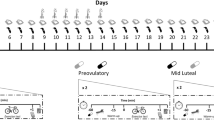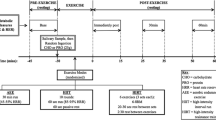Abstract
Purpose
The aim of this study was to investigate the effect of the menstrual cycle on the anaerobic power of short duration in healthy adult women.
Methods
Twenty-one subjects submitted to three Wingate tests. The following indicators were assessed: anthropometric measurements, body composition, physical activity level, maximum power average, fatigue index, and heart rate. Initially, the Wilcoxon test was made for analysis of heart rate during recovery.
Results
The findings suggest no statistically significant difference between the mid-follicular phase and late luteal for absolute power peak (508.19–503.29), and relative (8.95–8.80), mean absolute power (357.52–354.24) and relative (6.32–6.18), respectively. However, the maximum heart rate was lower and significant (180.48–183.90, p = 0.01) in the mid-follicular phase.
Conclusion
The mid-follicular and late luteal phases of the menstrual cycle have no influence on the performance of anaerobic power of short duration in college students.

Similar content being viewed by others
References
Azam A, Khosravi N, Zahra NR (2013) Effets of the menstrual cycle phase on the blood lactate responses and exercise performance in active women. Euro J Exp Biol 3(3):206–210
Bar-Or O (1987) The Wingate anaerobic test: An update on methodology, reliability and validity. Sports Med 6:381–394
Bushman B, Masterson G, Nelsen J (2006) Anaerobic power performance and the menstrual cycle: eumenorrheic and oral contraceptive users. J Sports Med Phys Fitness 46(1):132–137
Bruinvels G, Burden R, Brown N, Richards T, Pedlar C (2016) The prevalence and impact of heavy menstrual bleeding (menorrhagia) in elite and non-elite athletes. PLoS ONE 11(2):e0149881
Craig CL, Marshall AL, Sjöström M, Bauman AE, Booth ML, Ainsworth BE, Pratt M, Ekelund U, Yngve A, Sallis JF, Oja P (2003) International physical activity questionnaire: 12-country reliability and validity. Med Sci Sports Exerc 35(8):1381–1395
de Bruyn-Prevost P, Masset C, Sturbois X (1984) Physiological response from 18–25 years women to aerobic and anaerobic physical fitness tests at different periods during the menstrual cycle. J Sports Med 24:144–148
de Zambotti M, Nicholas CL, Colrain IM, Trinder JA, Baker FC (2013) Autonomic regulation across phases of the menstrual cycle and sleep stages in women with premenstrual syndrome and healthy controls. Psychoneuroendocrinology 38(11):2618–2627
Fernández G, Weis S, Stoffel-Wagner B, Tendolkar I, Reber M, Beyenburg S, Klaver P, Fell J, De Greiff A, Ruhlmann J, Reul J, Elger CE (2003) Menstrual cycle-dependent neural plasticity in the adult human brain is hormone, task, and region specific. J Neuro 23(9):3790–3795
Gamelin FX, Berthoin S, Bosquet L (2006) Validity of the polar S810 heart rate monitor to measure R–R intervals at rest. Med Sci Sports Exerc 38(5):887–893
Giacomoni M, Bernard T, Gavarry O, Altare S, Falgairette G (2000) Influence of the menstrual cycle phase and menstrual symptoms on maximal anaerobic performance. Med Sci Sports Exerc 32:486–492
Guyton AC, Hall JE (2000) Textbook of medical physiology, 10th edn. Saunders, Philadelphia
Harper JF, Hong B, Hwang I, Guo HQ, Stoddard R, Huang JF, Palmgren MG, Sze H (1998) A novel calmodulin-regulated Ca2+-ATPase (ACA2) from Arabidopsis with an N-terminal autoinhibitory domain. J Biol Chem 273(2):1099–1106
Inbar O, Bar-OR O, Skinner JS (1996) The Wingate anaerobic test. Human Kinetics, Champaign
Lamina S, Hanif S, Muhammed H (2011) Influence of menstrual cycle on maximal aerobic power of young female adults. AJPARS 3(1):36–41
Lebrun CM, Mckenzie DC, Prior JC, Tauton JE (1995) Effects of menstrual cycle phase on athletic performance during exercise. Med Sci Sports Exerc 27(3):437–444
Lebrun CM, Petit MA, Mckenzie DC, Tauton JE, Prior JC (2003) Decreased maximal aerobic capacity with use of a triphasic oral contraceptive in highly active women: a randomised controlled trial. Br J Sports Med 37(4):315–320
Masterson G (1999) The impact of menstrual phases on anaerobic power performance in collegiate women. J Strength Cond Res 13(4):325–329
Maughan R, Leiper JB, Shirreffs SM (1997) Factors influencing the restoration of fluid and electrolyte balance after exercise in the heat. Br J Sports Med 31:175–182
Middelton LE, Wenger HA (2006) Effects of menstrual phase on performance and recovery in intense intermittent activity. Eur J Appl Physiol 96:53–58
Myerburg RJ, Cox MM, Interian A Jr, Mitrani R, Girgis I, Dylewski J, Castellanos A (1999) Cycling of inducibility of paroxysmal supraventricular tachycardia in women and its implications for timing of electrophysiologic procedures. Am J Cardiol 1(83):1049–1054
Okudan N, Gokbel H, Uçok K, Baltace A (2005) Serum leptin concentration and anaerobic performance do not change during the menstrual cycle of young females. Neuroendocrinol Lett 26(4):297–300
Parish HC, Jakeman PM (1987) The effects of menstruation upon repeated maximal sprint performance. J Sports Sci 1:78
Redman LM, Weatherby RP (2004) Measuring performance during the menstrual cycle: a model using oral contraceptives. Med Sci Sports Exerc 36(1):130–136
Rosano GM, Leonardo F, Sarrel PM, Beale CM, De Luca F, Collins P (1996) Cyclical variation in paroxysmal supraventricular tachycardia in women. Lancet 347:786–788
Shaharudin S, Ghosh AK, Ismail AA (2011) Anaerobic capacity of physically active eumenorrheic females at mid-luteal and mid-follicular phases of ovarian cycle. J Sports Med Phys Fitness 51(4):576–582
Shephard RJ (1988) PAR-Q, Canadian home fitness test and exercise screening alternatives. Sports Med 5(3):185–195
Štefanovský M, Péterová A, Vanderka M, Lengvarský L (2016) Influence of selected phases of the menstrual cycle on performance in Special judo fitness test and Wingate test. Acta Gymnica 46(3):136–142
Tsampoukos A, Peckham EA, James R, Nevill ME (2010) Effect of menstrual cycle phase on sprinting performance. Eur J Appl Physiol 109(4):659–667
Wiecek M, Szymura J, Maciejczyk M, Cempla J, Szygula Z (2016) Effect of sex and menstrual cycle in women on starting speed, anaerobic endurance and muscle power. Acta Physiol Hung 103(1):127–132
Wojtys EM, Huston LJ, Lindenfeld TN, Hewett TE, Greenfield ML (1998) Association between the menstrual cycle and anterior cruciate ligament injuries in female athletes. Am J Sports Med 26(5):614–619
Yazar S, Yazıcı M (2016) Impact of menstrual cycle on cardiac autonomic function assessed by heart rate variability and heart rate recovery. Med Princ Pract. 25(4):374–377
Acknowledgements
The authors wish to thank all the participants involved in the study, for their patience and committed involvement.
Author information
Authors and Affiliations
Corresponding author
Ethics declarations
Conflict of interest
The authors declare that they have no conflict of interest.
Ethical approval
All procedures performed in studies involving human participants were in accordance with the ethical Standards of the institutional or national research committee and with the 1964 Helsinki declaration and its later amendments or compatible ethical Standards.
Informed consent
Informed consent was obtained from all individual participants included in this study.
Electronic supplementary material
Below is the link to the electronic supplementary material.
Rights and permissions
About this article
Cite this article
Pestana, E.R., Salvador, E.P., Pereira, G.B. et al. Influence of the mid-follicular and late luteal phases on anaerobic power in university students. Sport Sci Health 13, 281–286 (2017). https://doi.org/10.1007/s11332-016-0344-3
Received:
Accepted:
Published:
Issue Date:
DOI: https://doi.org/10.1007/s11332-016-0344-3




